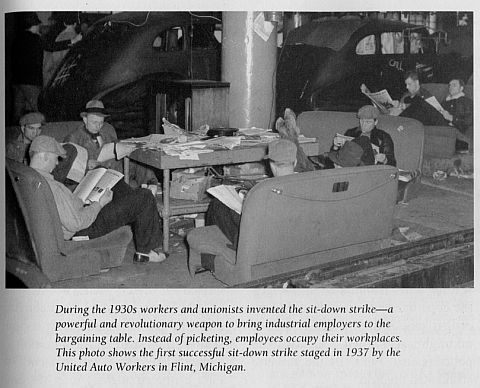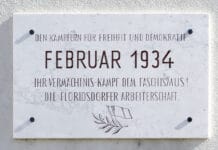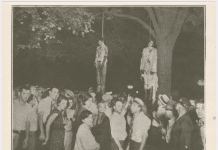Links on US strikes and labour struggles in the 1930’s, mostly on the strikes of transport workers/teamsters in 1934 and General Motors in 1936-37.
- Harlan County 1931
- Strejker i 1930’erne / Strikes in the 1930’s
- Transportarbejder-strejkerne 1934 / Teamsters Minneapolis Strike 1934
- General Motors-strejkerne 1936 / General Motors (Flint) 1936
[sta_anchor id=”1931″ /]
Harlan County 1931
- Battle of Evarts (Wikipedia.org)
- Harlan County War (Wikipedia.org)
Song:
- Which Site Are You On (song) (Wikipedia.org)
- Which Site Are You On. Almanac Singers, 1941 (YouTube.com, 2:12 min.). Version with lyrics (Natalie Merchant)
- Which Site Are You On. Florence Reece original (YouTube.com). From meeting at the 1973 strike.
Se også:
- Harlan County. Directed & produced by Barbara Kopple, 1977 (Archive.org, 104 min.). Documentary about 1973 struggle.
- Harlan County, USA (film) (Wikipedia.org)
- Harlan County, USA: The miners’ struggle. Review by Peter Biskind (Jump Cut, No.14, 1977)
- Harlan County, USA: The documentary form. Review by E. Ann Kaplan (Jump Cut, No.15, 1977)
[sta_anchor id=”1930″ /]
Strejker i 1930’erne
San Francisco General Strike, 1934 – Part 1 and part 2 (YouTube, 1:39 min., 1:04 min.). Union workers in San Francisco stage a general strike, shutting down the city to support striking longshoremen.
1934 West Coast Waterfront strike (Wikipedia.org)
America’s last violent strike has been wrongly forgotten (Jacobin, April 14, 2024). Benjamin Y. Fong interviews Ahmed White: “The 1937 Little Steel strike is often dismissed as a failure and relegated to a footnote. But it was a courageous organizing effort and a crucial moment in US labor history — revealing the limits of the New Deal order and the deepest dynamics of capitalism.”
To make unions resonate again, study the CIO’s history (Jacobin, April 7, 2024). Benjamin Y. Fong interviews Lisa Phillips:
“Declining union density has diminished American workers’ awareness of labor organizing, pride in union status, and sense of belonging to a tradition of collective struggle. The history of the CIO can teach us how to embed unions in the working class again.”
Don’t write off US union organizing before the CIO (Jacobin, March 27, 2024). Benjamin Y. Fong interviews Dorothy Sue Cobble:
“The Congress of Industrial Organizations is often understood to the be the innovative, solidarity-based alternative to the American Federation Labor, its immediate predecessor. But the CIO had limits too — and the AFL had more to offer than it gets credit for.”
Unions can’t be rebuilt piecemeal. We need to go big (Jacobin, March 10, 2024). Benjamin Y. Fong interviews Erik Loomis:
“The 1930s rise of the Congress of Industrial Organizations led to millions of people being union members for the first time. The lesson of the CIO is that it’s necessary to harness the collective power of the working class on a grand scale.”
The West Coast was once a cradle of class struggle (Jacobin, January 19, 2024). Benjamin Y. Fong interviews Robert Cherny:
“In the depths of the Great Depression, maritime and waterfront workers on the Pacific Coast of the US — from Bellingham, Washington, to San Diego, California — erupted in militant strikes against their shipping magnate employers.”
For a model of working-class mass organizing, look to the CIO (Jacobin, January 17, 2024). Benjamin Y. Fong interviews Steve Fraser:
“The level of anti-capitalist sentiment in the US today hasn’t been seen since the 1930s. Labor radicals seized that moment to create the pivotal Congress of Industrial Organizations. We should take lessons from their achievements — and their missteps.”
The Minneapolis truckers’ strike was led by Left revolutionaries (Jacobin, January 14, 2024). Benjamin Y. Fong interviews Bryan D. Palmer:
“When the Great Depression sank workers to new depths, craft unions weren’t up to the task. Then, in 1934, a team of revolutionary leftists in Minneapolis organized a brave and bloody strike that reinvigorated labor and changed the course of American history.”
By emphasizing unity over division, the CIO birthed a new Labor movement (Jacobin, January 9, 2024). Benjamin Y. Fong interviews Lizabeth Cohen:
“Workers in the US were deeply split in the 1930s, not least by race and ethnicity. To organize greater swaths of the working class, the Congress of Industrial Organizations had to turn division into solidarity.”
The sit-down strike was born when Akron rubber workers opted to stay put, not walk out (Jacobin, January 9, 2024). Benjamin Y. Fong interviews Daniel Nelson:
“In the 1930s, unions grabbed headlines and won major battles with sit-down strikes, where striking workers occupied their workplaces. The fiery tactic put the Congress of Industrial Organizations on the map and struck fear in the hearts of business elites.”
Worker insurgency and the New Deal (Tempest, December 20, 2022)
“Kim Moody interrogates Eric Blanc’s account of the relationship between the Democrats and working-class self-activity in the New Deal era.”
See also Kim Moody: Worker insurgency and the New Deal: “Explaining” strikes for union recognition (Ibid., December 20, 2022)
Even in a pandemic, workers can fight back. By Nick French (Jacobin, 11 April 2020)
“During the Great Depression, radicals played key roles in helping organize the worker upsurges that led to the New Deal’s pro-worker policies. We can do the same today …”
Lessons from the 1937 Little Steel strike in the US. By Tom Mackaman (World Socialist Web Site, 23 January 2017). Review of Ahmed White, The Last Great Strike: Little Steel, the CIO, and the Struggle for Labor Rights in New Deal America (University of California Press, 2016)
Fighting back. By Megan Trudell (Socialist Review, Issue 372, September 2012, online at Internet Archive). Review of John Newsinger, Fighting back: the American working class in the 1930s (Bookmarks, 2012)
“In this splendid corrective John Newsinger tells a very different – and often hidden – history of the dramatic strikes and sit-down movement of the 1930s …”. See also John Newsinger: Once upon a time in America (Socialist Worker, Issue 2313, 28 July 2012; online at Internet Archive)
1934: Strike wave in the South (SocialistWorker.org, August 22, 2012)
“Russell Pryor examines the obstacles faced by Southern workers during the General Textile Strike of 1934.”
Fighting evictions during the Great Depression: the Great Rent Strike War of 1932 in the Bronx. By Mark Naison (International Socialist Review, Issue 81, January-February 2012)
“… by an accident of geography and sociology, this neighborhood contained one of the largest concentrations of communists in New York City.”
The sit-down strikes (1990). By Sharon Smith (SocialistWorker.org, June 10, 2011)
“The years 1936 and 1937 represented the highest point of class struggle in the U.S. to date – when a wave of sit-down strikes swept across U.S. industry. Those strikes built the Congress of Industrial Organizations and changed the face of the labor movement.”
1937: the year of the sitdown (International Socialism, Issue 127, Summer 2010, p.81-110)
“John Newsinger discusses the grat wave of sitdown strikes in the mid1930s that broke bosses’ resistance to the unionisation of basic industry in the United States.”
The unemployed movement of the 1930s: Bringing misery out of hiding. By Danny Lucia (International Socialist Review, Issue 71, May-June 2010)
“The Communist Party, Socialist Party, and followers of radical pacifist A.J. Muste created unemployed organizations that mobilized hundreds of thousands of jobless workers in local and national protests.”
1934: year of the fightback. By John Newsinger (International Socialism, Issue 122, Spring 2009, p.65-90)
“John Newsinger looks at how workers fought back in the face of vicious attacks by employers and the state, and despite initially weak trade unions.”
The lessons of 1934. By Sharon Smith (SocialistWorker.org, October 6, 2009)
“The year 1934 marked a turning point for the working-class struggle during the Great Depression, with three strikes in three cities – Toledo, San Francisco and Minneapolis – that showed workers could fight back and win.”
The battle for the docks (SocialistWorker.org, September 21, 2009)
“Here, Todd Chretien tells how the battle of longshore workers, led by members of the Communist Party, against the tyranny of the port bosses led to the largest general strike in American history.”
75 years since the San Francisco general strike. By Marge Holland and Robert Louis (World Socialist Web Site, 18 September 2009)
“On May 9, 1934, San Francisco longshoremen went out on strike against West Coast ship owners, igniting a movement of 35,000 maritime workers of the International Longshoremen’s Association (ILA) that shut down 2,000 miles of Pacific coastline from Bellingham, Washington, to San Diego, California.”
Labor’s breakthrough in Toledo (SocialistWorker.org, 15 September 2009)
“Here, Elizabeth Schulte tells the story of the Auto-Lite strike in Toledo, Ohio, where workers and the unemployed united to beat back the bosses and their troops.”
75th anniversary of the Toledo Auto-Lite strike: Historic 1934 struggle. By Charles Bogle (World Socialist Web Site, 27 May 2009)
“This year marks the 75th anniversary of the Toledo, Ohio, Auto-Lite strike. From February until June 1934, the city of Toledo, Ohio – a major industrial city on Lake Erie – was gripped by the workers’ struggle against the auto parts manufacturer, Electric Auto-Lite.”
20. juli 1934
“Bloody Friday” i Minneapolis, USA, da 67 lastbilchauffører og sympatisører blev skudt ned under strejken, der endte med sejr. / Bloody Friday in Minneapolis, USA: 67 lorry drivers and activists were killed.
See:
- Minneapolis Teamsters Strike of 1934 (Wikipedia.org)
- Video: Labor’s turning point (YouTube.com, 43:06 min.). “Full-length documentary on the 1934 Truckers Strikes.”
- Section: 1934 Minneapolis Teamster Strikes (Marxists Internet Archive; History Archive. Bl.a. bogen: American City (1937) by Charles Rumford Walker: “First hand narration and interviews with the major participants of the strike.”
Revolutionary Teamsters: The Minneapolis Teamsters Strike of 1934. By Richard Allday (Counterfire, October 15, 2015). Review of Brian D. Palmer’s book (Haymarket Press 2014, 352 p.)
“Brian Palmer’s Revolutionary Teamsters shows the contemporary relevance of a major episode of revolutionary trade-unionism from the 1930s.” See the book online at Libcom. See also Brian D. Palmer: Teamsters and Cops (Jacobin, July 15, 2016) + interview with Brian D. Palmer: The Minneapolis truckers’ strike was led by Left revolutionaries (Jacobin, January 14, 2024).
The Teamster rebellion of 1934 (SocialistWorker.org, May 20, 2011)
“Three strikes in 1934 helped transform the situation. Phil Gasper looks at the Teamster rebellion in Minneapolis.”
The Teamsters’ rebellion sparked struggle (Socialist Worker, Issue 2227, 13 November 2010)
“Mass strikes rocked the US in the 1930s, with rank and file workers and revolutionaries at the heart of them. Simon Basketter looks at the key events of Minneapolis in 1934.”
The rebellion in Minneapolis (SocialistWorker.org, September 29, 2009)
“Here, Adam Turl how a wave of strikes that started with coal drivers drew in growing numbers of workers – and provoked bigger and bigger confrontations with big business and the state.”
75th anniversary of the Minneapolis truck drivers’ strike: Revolutionary leadership and the struggle of 1934. By Ron Jorgenson (World Socialist Web Site, 31 August 2009)
“We are posting here an article on the 1934 Minneapolis general truck drivers’ strike, originally published in four parts.”
US: The 75th anniversary of the 1934 Minneapolis Teamsters strike. Part 1. By David May (In Defence of Marxism, 17 July 2009) + Part 2 (24 September 2009)
“The 1934 Teamsters strike in Minneapolis, led by the Trotskyists of the Communist League of America (the forerunner of the Socialist Workers Party), was a decisive moment in the US labor and socialist movements. During the years preceding the strike, few would have expected the upsurge that took place in 1934.”
70th anniversary of Labor’s historic victory in Minneapolis (SocialistWorld.net, 23 January 2005)
“Seventy years ago, a small mid-western city was shaken to its very foundations. The 1934 Minneapolis Teamster strike is one of the greatest labor battles in U.S. history. For two months, the working class owned the streets.”
Rebellion in Minneapolis (SocialistWorker.org, March 20, 2009). Uddrag fra Sidney Lens’ bog: The Labor Wars: From the Molly Maguires to the Sit-Downs (2009/1973)
“Here, we reprint an excerpt from a chapter of The Labor Wars that chronicles some of the crucial union battles of the Great Depression – strikes on the West Coast waterfront strike, at the Auto-Lite plant in Toledo, Ohio, and of Teamsters in Minneapolis in 1934.”
The 1934 Minneapolis Strike (1934). By Carl Skoglund (Revolutionay History, Vol.2, No.1, Spring 1988)
“The Minneapolis strikes of 1934 have always occupied a special place in the historical understanding of the Trotskyist movement, as they were the first clearly documented demonstration of the ability of a small Trotskyist organisation to make the breakthrough into the broader labour movement, and to lead one of its sections to victory.”
Learn from Minneapolis! By James P. Cannon (The Militant, May 26, 1934)
“… strange new force in the labor movement, an influence widening and extending like a spiral wave. Out of the strike of the transport workers of Minneapolis a new voice speaks and a new method proclaims its challenge.”
The secret of Local 574. By James P. Cannon (Marxists Internet Archive). From the Daily Strike Bulletins of the 1934 Truckers Strike Minneapolis””August 18, 1934.
“… they study the experiences of other workers and learn from them.”
Part II: Minneapolis Teamsters Strike Documentary Part 2 (Youtube.cm, 16:51 min.)
Books:
US workers: from despair to victory. By John Newsinger (Socialist Review, Issue 387, January 2014; online at Internet Archive). Review of Bryan Palmer, Revolutionary Teamsters: Revolt in Minneapolis 1934 (Brill/Haymarket, 2013/2014, 308 p.). See also Bryan D. Palmer: Red Teamsters (Jacobin, 14 October 2014)
The Year 1934: Three reviews of Bryan Palmer’s “Revolutionary Teamsters” (Solidarity, July 8, 2014). “The year 1934 saw three historic strikes that transformed U.S. labor… The left played a critical leading role in all three strikes.”
Teamsters Rebellion. By Farrell Dobbs (Monad Press/Pathfinders Press, 1972, 190 p.). See book review by Matt Wells (Socialist Appeal, 17 July 2007). “The first of four books in a series, this is a true life account of the struggles for union recognition fought by the transport workers in Minnesota, US in 1934.”

30. december 1936
Bilarbejderne i Flint, Michigan, starter besættelser, der fører til 135.000 i strejke mod General Motors. “The most important strike in American labor history.”
See:
- Flint Sit-Down Strike (Wikipedia.org) + very good links.
- The Flint sit-down strike audio gallery: Remembering the Flint sit-down strike 1936-1937 (HistoricalVoices.org)
Introduction, organization, strike, aftermath + audio timeline, strike map, slideshow.
Remembering the first clash between UAW and GM. By Meagan Day (Jacobin, October 1, 2019). “Today’s strike at GM recalls the Flint sit-down strikes of 1936-7: a profit-hungry corporation, a fed-up workforce, and a conciliatory union leadership. But it lacks something important: a strong ‘militant minority’.”
The Flint Militants. By Julian Guerrero (Jacobin, October 13, 2017). “Eighty years ago, the Flint Sit-Down Strike showed the power of a determined rank and file and a class-conscious leadership.”
Eighty years since the victory of the Flint sit-down strike. Part 1-2. By Jerry White (World Socialist Web Site, 15-16 February 2017). “The 44-day battle … forced General Motors, then the largest industrial enterprise on the planet, to recognize the recently founded United Auto Workers union.”
When workers occupied (SocialistWorker.org, October 18, 2011)
Excerpt from Sharon Smith’s book, Subterranean Fire: A History of Working-Class Radicalism in the United States (Haymarket, 2006, p.135-142)
Flint occupation lit a flame. By Sadie Robinson (Socialist Worker, Issue 2162, 1 August 2009)
“In 1936 car workers occupied their factory in Flint in the US and won a victory over the General Motors corporation. The struggle holds lessons for today.”
70 years ago workers won Flint sit-down strike: 1937 Flint sit-down labor history series, Part 1-10. By Martha Grevatt (Workers World, February 28-June 8, 2007)
The Flint sitdown for beginners. Introduction by Charlie Post (Against the Current, No.62, May/June 1996):
- Flint and the rewriting of history. By Sol Dollinger (Against the Current, No.62, May/June 1996)
“It is understandable that these events, which were led by radical political parties, would produce partisan perceptions of these historic happenings. In the main this history has been the major province of the supporters of the Communist Party (CP).” - Politics and memory in the Flit sitdown strikes. By Nelson Lichtenstein (Against the Current, No.62, May/June 1996)
“Sol Dollinger renders a great service in correcting the historical record. Whether by omission or outright bias, Henry Kraus has slighted the role played by Socialist Party activists in the leadership of the Flint sit-down strikes.”
Striking Flint (1995) (Marxists Internet Archive)
“Genora (Johnson) Dollinger remembers the 1936-37 General Motors sit-down strike … as told to Susan Rosenthal 1995.”
The Flint Sit-down Strike of 1936-1937. By Laureen Brady & Cloe Rose Less (YouTube, 6:33 min.)
Se også / See also:
Oprørskhed og naivitet: ny litteratur om arbejdskampe i USA (pdf). By John Logue (Årbog for arbejderbevægelsens historie, nr. 9, 1979, side 275-287). En forsknings og litteraturoversigt.
Se på Socialistisk Bibliotek:
- Emneoversigten: USA / United States of America
- Linkboxen: Wall Street krisen 1929
- Linkboxen: New Deal-politikken i USA





























